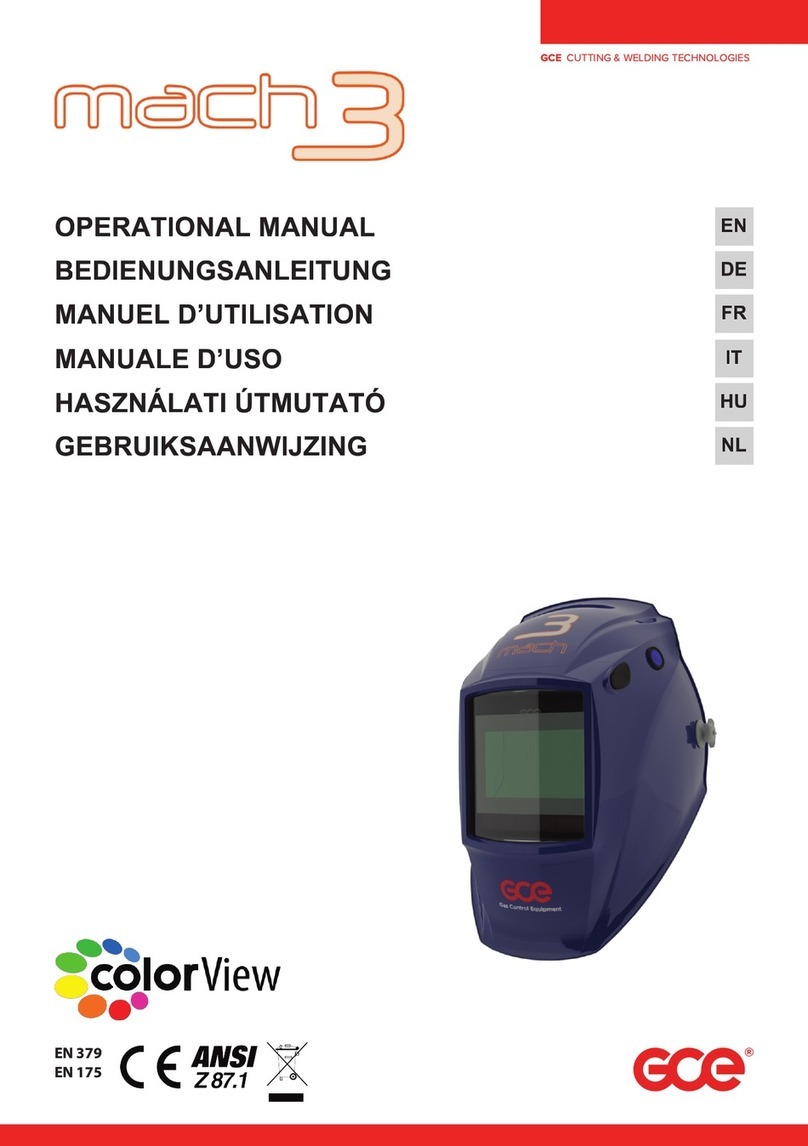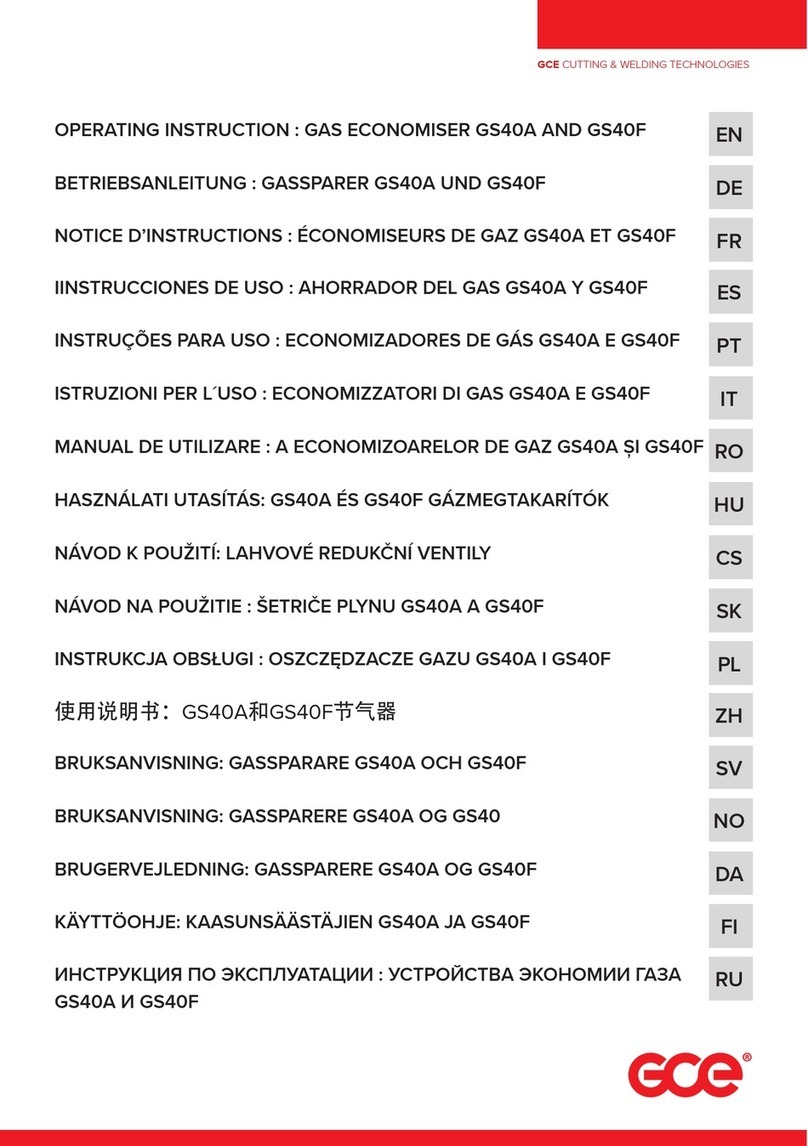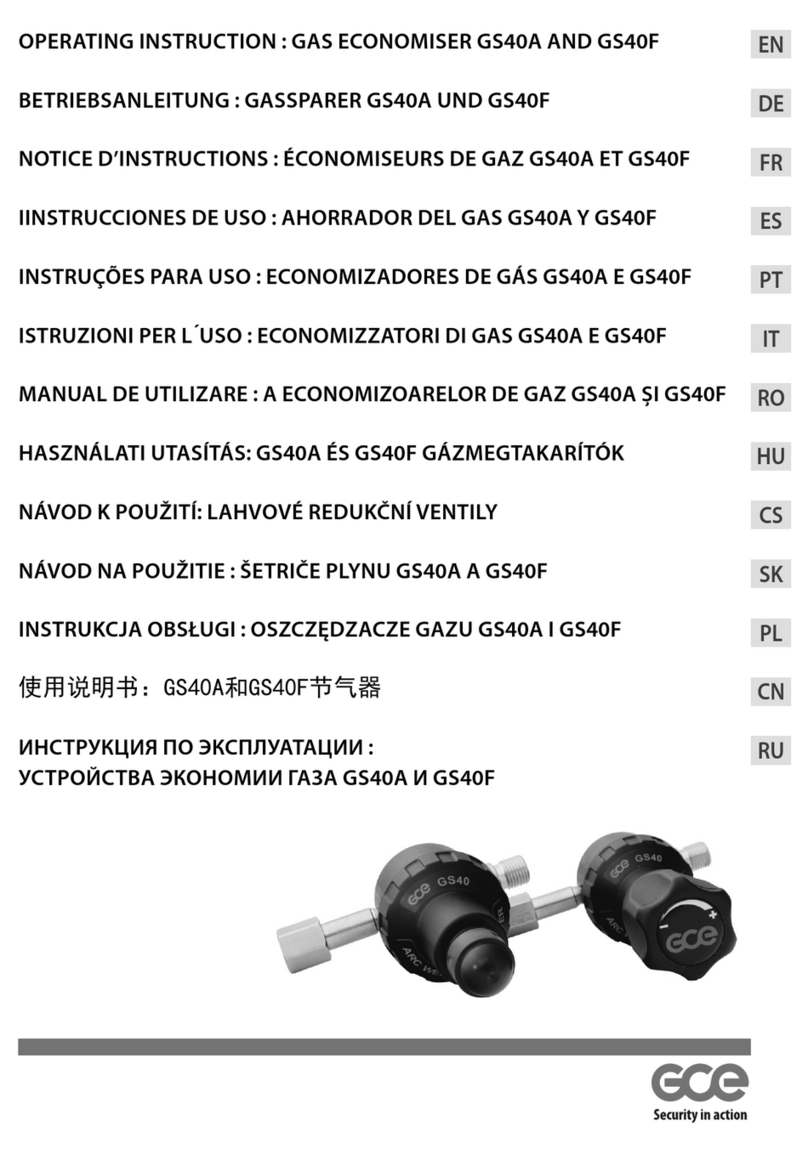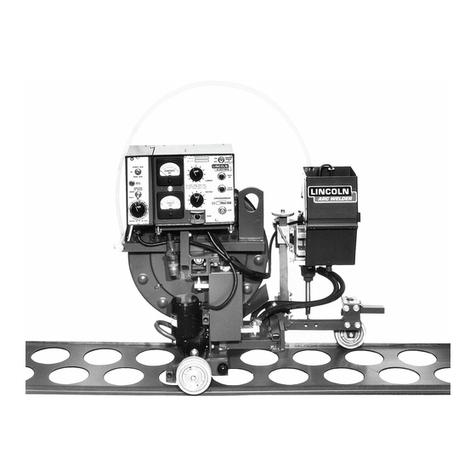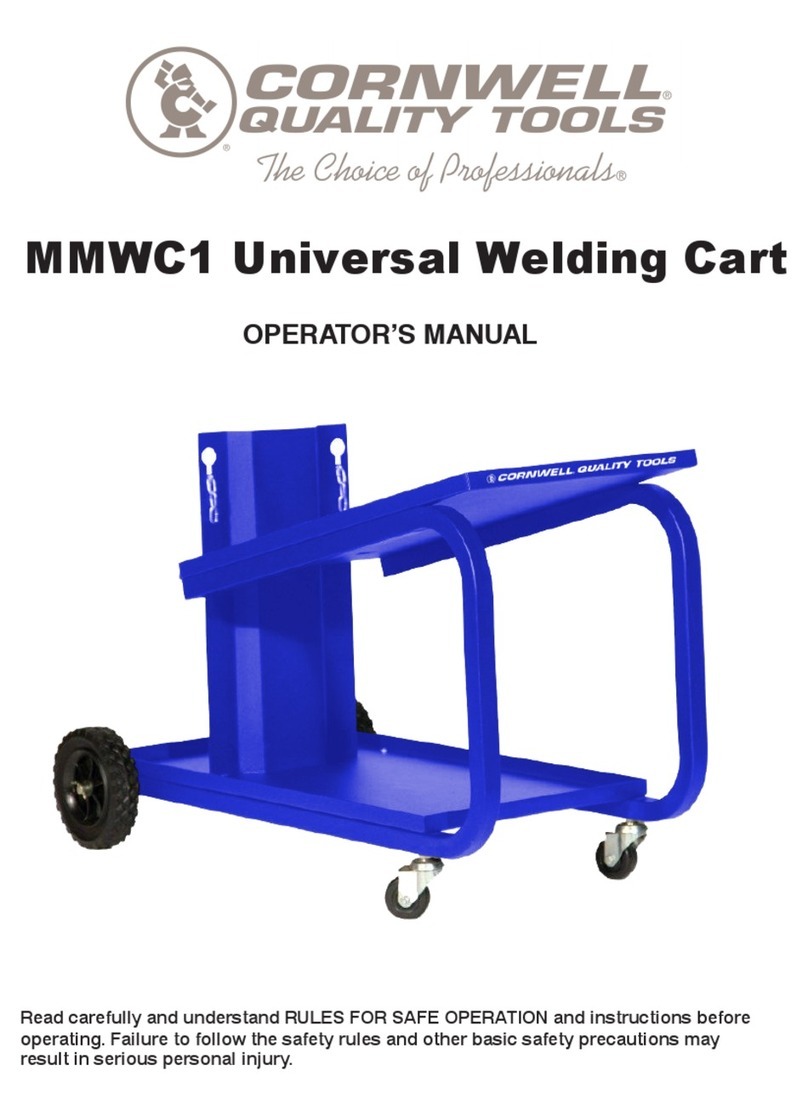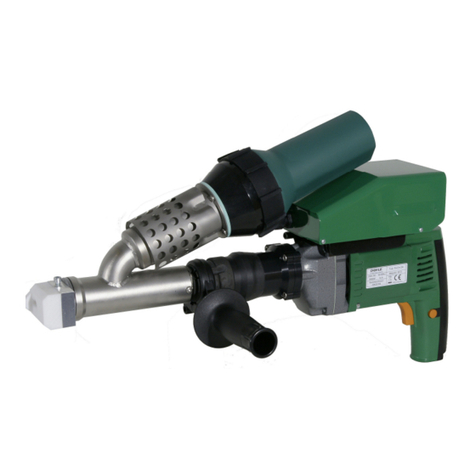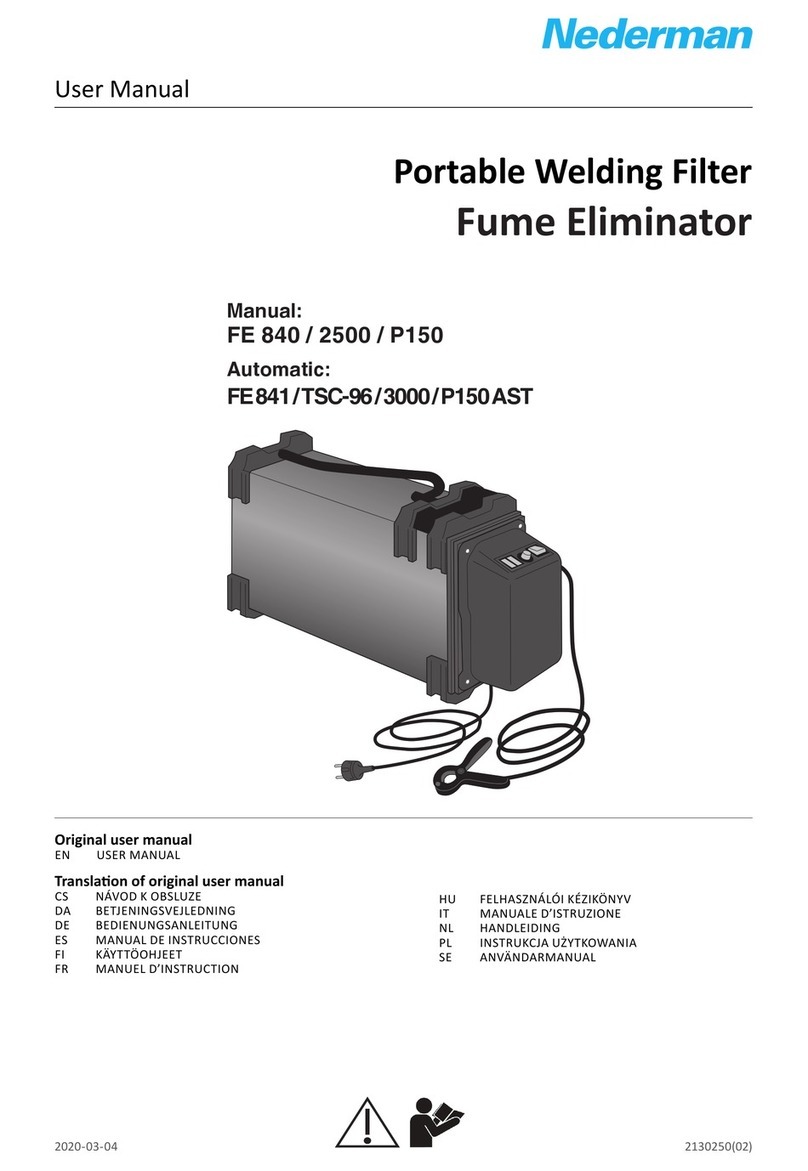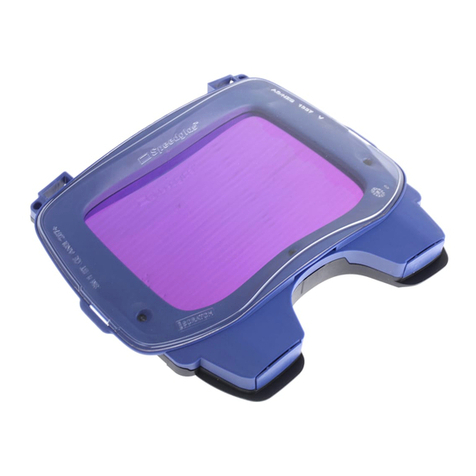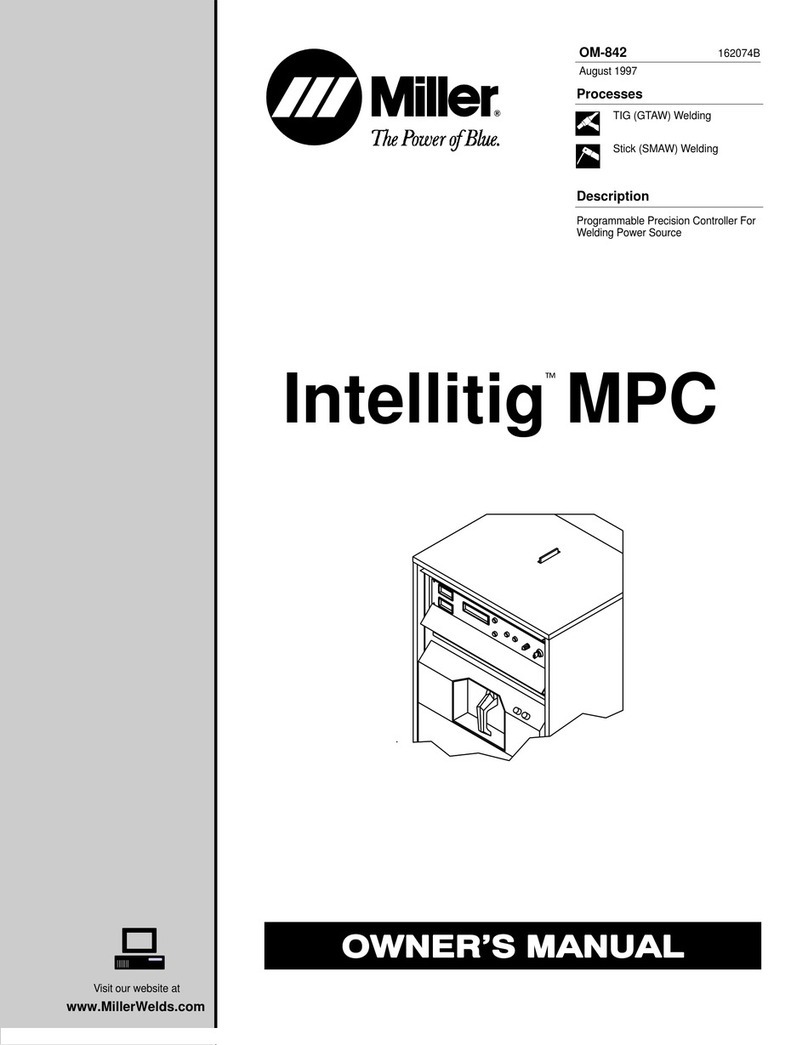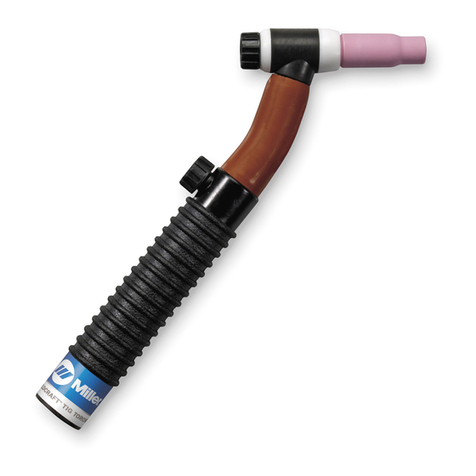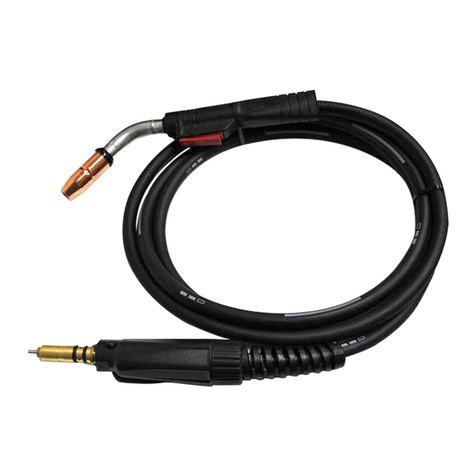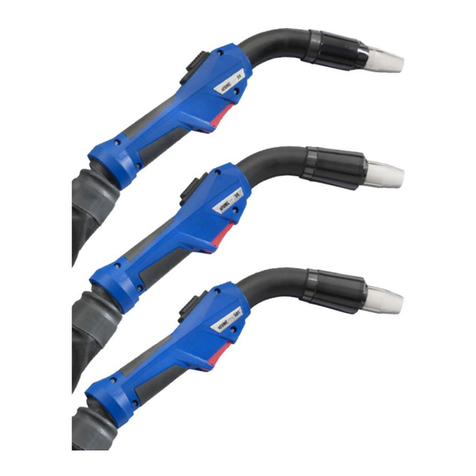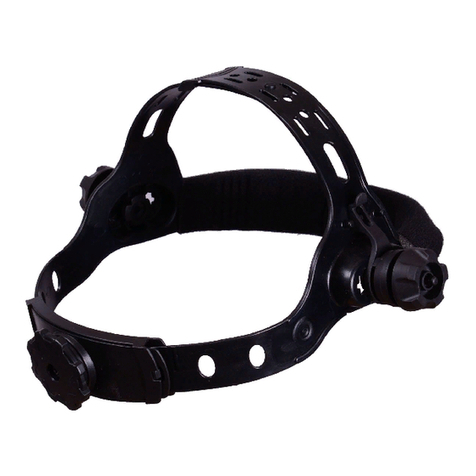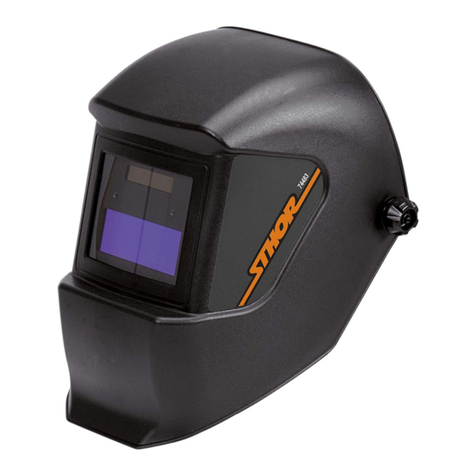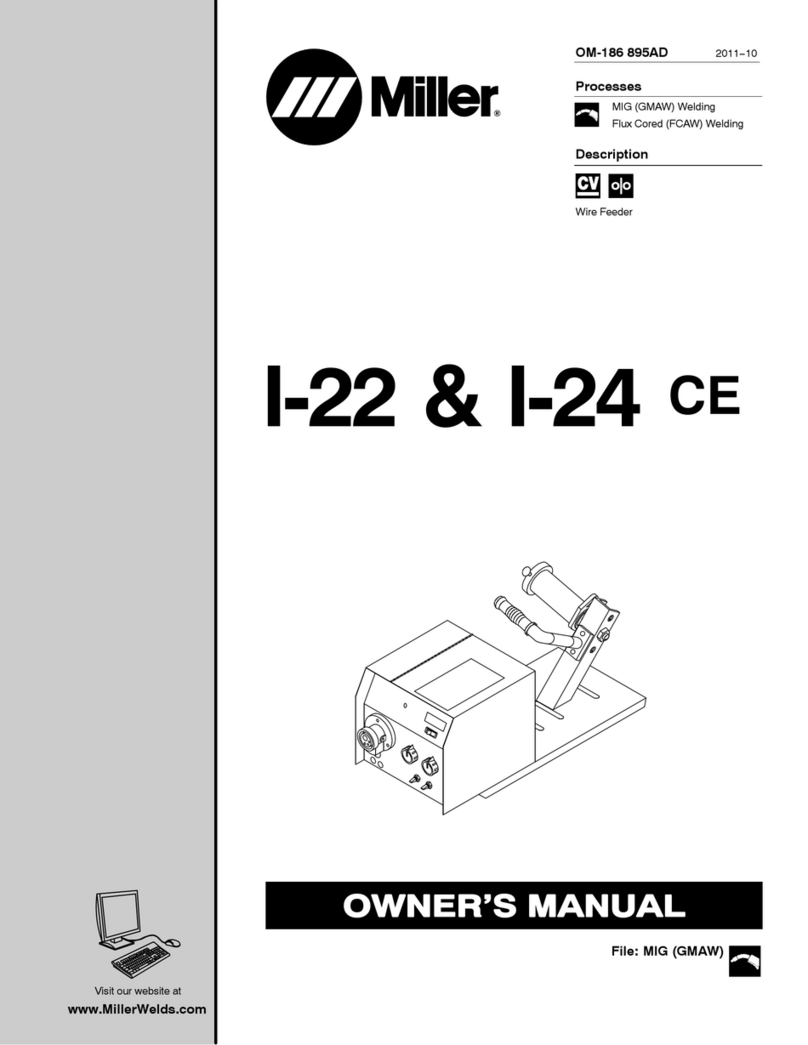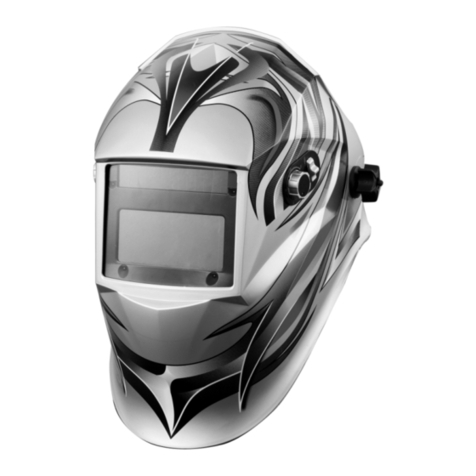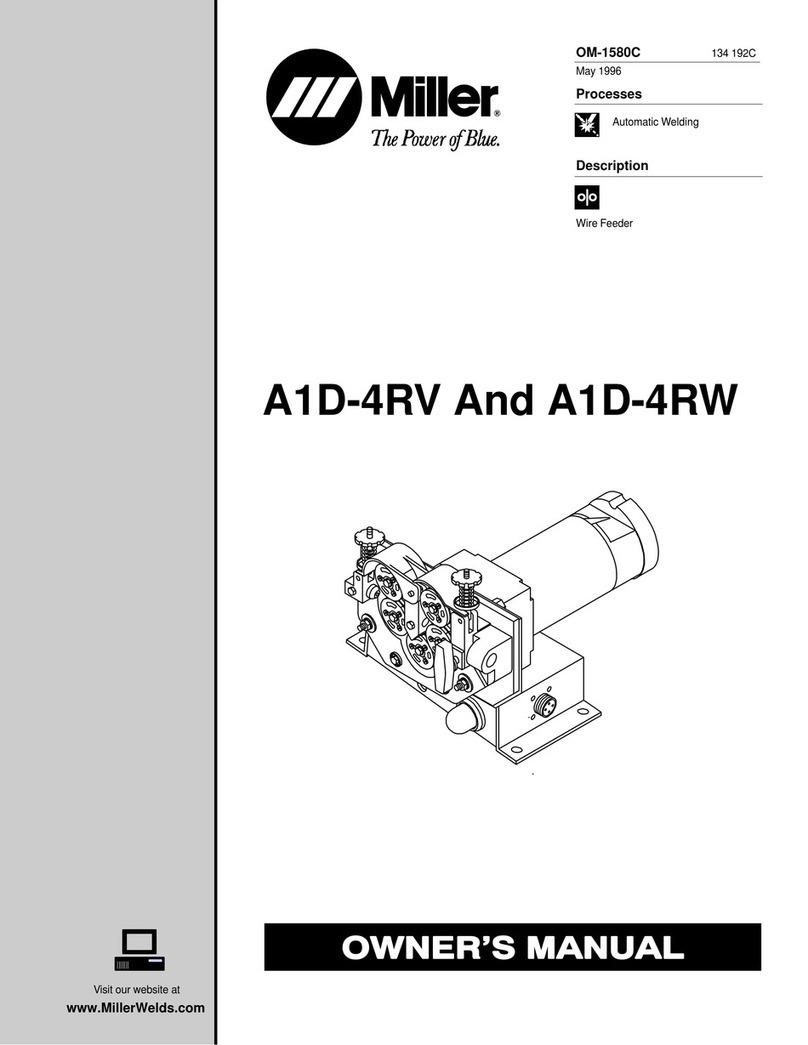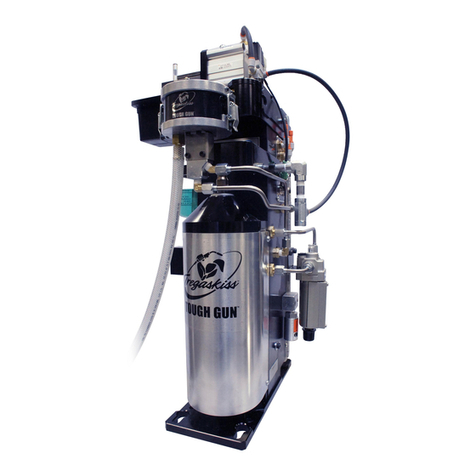GCE Horus Quick start guide

1 /1 6
OPERATIONAL MAN AL EN
MAN EL D’ TILISATION FR
MAN ALE D’ SO IT
HASZNÁLATI ÚTM TATÓ H
EN 379
EN 1 75

2/1 6
Pleasereadthis manual carefullybeforeusingtheAutomaticWeldingMask
1 . S MMARY
The
HORUS
Auto Darkening Welding Helmet is a new generation product for labor protection. Some new
and high science and technology such as LCD, optoelectronics detection, solar power, microelectronics,
etc. are integrated into it. The automatic welding mask not only can efficiently protect operator's eyes
from injuries caused by arc, but also can make both hands free and strike arc accurately. Therefore, the
quality of products and work efficiency may be raised considerably. It may be widely used for various
welding, cutting, spraying and arc gouging, etc.
2. WARNING
Read and understand all instructions before using.
•
Be sure that the dark shade of the lens in the welding helmet is the correct shade number for your
application.
•
The helmets and lenses are not suitable for "overhead” welding application, laser welding, or laser
cutting applications.
•
Welding helmets are designed to protect the eyes and face from sparks, spatter, and harmful radiation
under normal welding conditions. They will not protect against severe impact hazards.
•
This helmet will not protect against explosive devices or corrosive liquids. Machine guards or eye splash
protection must be used when these hazards are present.
•
Impact resistant, primary eye protection, spectacles or goggles that meet current specifications, must
be worn at all times when using this welding helmet.
•
Avoid work positions that could expose unprotected areas of the body to spark, spatter, direct and/or
reflected radiation. Use adequate protection if exposure cannot be avoided.
•
Check for light tightness before each use. Before each use, check that the protection plates are clean
and that no dirt is covering the sensors on the front of the lens.
•
Inspect all operating parts before each use for signs of wear or damage. Any scratched, cracked, or
pitted parts should be replaced immediately.
•
Do not make any modifications to either the welding lens or helmet, other than those specified in this
manual. Do not use any replacement parts other than those specified in this manual. Unauthorized
modifications and replacement parts will void the warranty and expose the user to the risk of personal
injury.
•
If this lens does not darken when striking arc, stop welding immediately and contact representative.
•
Do not immerse this lens in water if this model is not water proof.
•
Do not use any solvents on any lens or helmet components.
•
The recommended operating temperature range for welding lens is 1 4°F ~ 1 49°F (-1 0°C ~ 65°C ). Do not
use this device beyond these temperature limits.
•
Failure to follow these warnings and/or failure to follow all of the operating instructions could result in
severe personal injury.
3. CHARACTERISTICS
The
HORUS
Auto Darkening Welding Helmet is equipped with a filter set that can become dark. The filter
is transparent before welding, so the operators may observe the work surface clearly. When striking arc,
the filter darkens automatically immediately. When arc goes out, the filter will become transparent again.
The switching time from light to dark is about 0.1 ms. There are 3 options for delay time: slow, medium
and fast. The mask is equipped with continuous darkness-adjusting unit, so the operator may select an
arbitrary dark shade number ranging from #9 to #1 3.
The
HORUS
Auto Darkening Welding Helmet gives the operators permanent complete protection against
UV/IR even in transparent condition. The UV/IR protection level is up to DIN1 5 in all time. The power is
provided by solar cells, so user is exempted from changing battery, turning on or off power and any other
operation.
The mask is equipped with 2 sets of photo-sensors to sense arc light. In addition, the mask is also provided
with an outer protection plate made of high polymer materials.
The plate is wear-resistant, thermostable, and has no dregs-sticking, thus a very long service life.
EN
ENGLISH

3/1 6
EN
4. PACKING LIST
1 piece Mask body (including control cassette)
1 piece Headband
1 piece Operation manual
5. SPECIFICATION
6. METHOD OF OPERATION
•
Assemble the mask as shown in the construction and assembly scheme (see fig. 1 )
•
The power supply
. The power of HORUS helmet is provided by solar cells with one lithium battery.
Turning on or off is automatic controlled by circuit. You can use this helmet at any time you need and
take it away after working without operating any key.
•
Darkness selection.
Striking the arc, the observing window darkens immediately. At this moment,
according to the technical requirement, the operator adjusts the darkness knob 5 in the direction
shown by the arrow to select the optimum darkness.
•
Delay time selection.
By moving the
DELAY
selector 1 0 on the rear of the cartridge, the time taken by
the lens to lighten after welding can be adjusted.
Turn to
FAST
: The time the lens lightens after welding is about 0.1 second depending upon welding
point temperature and shade setting. This setting is ideal for track welding or production welding with
short welds.
Turn to
MEDIUM
: The time the lens lightens after welding is about 0.5 second depending upon welding
point temperature and shade set.
Turn to
SLOW
: The time the lens lightens after welding is about 0.9 second depending upon welding
point temperature and shade setting. This setting is ideal for welding at high amperage where there is
an after glow from the weld.
•
Sensitivity selection
. By moving the
SENSITIVITY
selector 9 on the rear of the cartridge, the sensitivity
to ambient light changes can be adjusted.
Turn to
LOW
: The photosensitivity changes to be lower. Suitable for high amperage welding and
welding in bright light conditions (lamp light or sun light).
Turn to
MEDIUM
: The photosensitivity changes to be medium. Suitable for medium amperage welding
and welding in medium light conditions.
Turn to
HIGH
: The photosensitivity changes to be higher. Suitable for low amperage welding and using
in poor light conditions. Suitable for using with steady arc process such as TIG welding.
If the helmet can be used normally, we suggest to use“HIGH” sensitivity.
•
The operator may adjust the headband adjusting button 1 3 and the segmental positioning plate 1 4 to
select an appropriate observing angle.
By pushing and turning the adjustment screw 12, the perimeter ofthe head band can be adjusted.
•
Grind Selection
Turn shade adjusting knob anti-clockwise until you feel knob “click”. You can now
grind with helmet. Remember to turn knob back when you want to weld again.
Optical Class 1 /1 /1 /2
Filter dimension 1 1 0 x 90 x 9 mm
View area 90 x 40 mm
Sensing 2 sensors
Light Shade #4
Dark Shades #9 - #1 3
Time from light to dark 0.1 msec (1 /1 0000 sec)
Time from dark to light
(Delay) Slow: 0.9 sec
Medium: 0.5 sec
Fast: 0.1 sec
Sensitivity Low, Medium, High
Grinding function Yes, external
Power Supply
Solar cell + 1 x CR2450 Lithium
battery not replaceable.
Auto power off Yes
UV/IR protection up to DIN 1 5
Operating temperature
-1 0°C ~ 65°C (1 4°F ~ 1 49°F )
Storage temperature
-20°C ~ 80°C (-4°F ~ 1 76°F)
Standards
EN379 (Filter) EN1 75 (Helmet)
CE – ANSI Z87.1

4/1 6
7. POINTS FOR ATTENTION
•
Be sure that the helmet is to be used in correct condition and check it according to WARNING content.
•
There is liquid crystal-valve in the filter, although it has inner and outer protection plate, it is important
to avoid heavy knock to break.
•
The outer protection plate of helmet should be periodically inspected and cleaned, keep it clear. In case
break, crack, pitting or more serious influencing vision effect occurs, the plate must be replaced.
•
In order to operate more efficiently and safely, please select correct dark shade number.
•
If the filter is not water-proof model, please pay attention to preventing from water.
•
Be sure that the arc light must be received completely by sensor, ifnot, the filter will be light or unstable
in darkness to damage the person.
•
Please use the automatic filter at temperature between -1 0°C ~ 65°C (1 4°F ~ 1 49°F )
•
Please don't disassemble the filter, any problems arising, please contact our company or agent.
8. CONSTR CTION AND ASSEMBLY SCHEME
Construction and assembly scheme See fig. 1 at the end of this manual.
9. SHADE SELECTION TABLE
See table at the end ofthis manual.
Note: Shade selection table from standard EN 1 69.
1 0. DISPOSAL
This device meets the requirements of the relative directives concerning the environmental
protection (2002/96/EC, 2003/1 08/EC, 2002/95/EC).
At the end of the products life cycle it must be disposed of according to the regulations
concerning special waste collection as it cannot be treated as normal urban refuse.
The product is made up of materials that are both non-biodegradable and of potentially polluting
substances to the environment if not disposed of correctly.
1 1 . WARRANTY
Made in China. GCE offers a 2 year warranty against defects in materials and manufacturing.
The complete Warranty conditions are described in the GCE Guarantee Certificate which is available on
the GCE website.
www.gcegroup.com
Inner protection plate
Outer protection plate
Helmet shell
Block nut
Automatic filter
Shade knob
6
1
2
3
4
5
Segmental positioning plate
Sensitivity knob
Delay knob
Screw for fixing headband
Headband tightness adjusting knob
Headband adjusting band
1 4
9
1 0
1 1
1 2
1 3
EN
Frame
7Sweat band
1 5
Fixing screw for frame
8Positioning point for the segmental plate
1 6

5/1 6
FR
FRANÇAIS
Nousvousprions de lirecemanuelavecsoin avant utilisation demasque de soudageautomatique.
1 . SOMMAIRE
Le masque de soudage automatique
HORUS
est un produit de nouvelle génération pour la protection au
travail. Des éléments de science et technologies avancées tels que LCD, détection optoélectronique,
l’énergie solaire, la microélectronique, etc. sont intégrés dans le masque. Le masque de soudage
automatique peut non seulement effectivement protéger les yeux de l’opérateur contre les blessures
causées par l’arc, mais peut également assurer d’avoir les deux mains libres et tirer l’arc avec précision. Par
conséquent, la qualité des produits et l’efficacité du travail peuvent augmenter considérablement. Le
masque peut être largement utilisé pour différentes opérations de soudage, découpage, de pulvérisation
et gougeage à l’arc, etc.
2. AVERTISSEMENT
Lire et comprendre toutes les instructions avant utilisation.
•
Assurez-vous que la teinte de la lentille dans le masque est le numéro de la nuance appropriée pour
votre application.
•
Ces masques et lentilles ne sont pas adaptés pour les applications de soudage “ dessus de la tête”,
soudage au laser, ou découpage au laser.
•
M
asques de soudage sont conçus pour protéger les yeux et face à des étincelles, des éclaboussures, et le
rayonnement nocif dans des conditions normales de soudage. Ils ne protègent pas contre les chocs sévères.
•
Ce masque ne protège pas contre les engins explosifs ou des liquides corrosifs. Protections mécaniques ou
protection contre éclaboussure dans les yeux doivent être utilisées lorsque ces dangers sont présents.
•
La protection oculaire primaire résistante aux chocs ou lunettes de protection qui répondent aux
spécifications en vigueur, doivent être portées obligatoirement en tout temps lors de l’utilisation de ce
masque de soudeur.
•
Évitez les positions de travail qui pourraient exposer sans protection les zones du corps à une étincelle,
éclaboussures, rayonnement direct et/ou reflet. Utiliser une protection adéquate l’exposition ne peut
pas être évitée.
•
Vérifier l’étanchéité contre la lumière avant chaque utilisation. Avant chaque utilisation, vérifiez que les plaques
de protection sont propres et qu’aucune impureté ne couvre pas les capteurs situés à l’avant de la lentille.
•
Inspectez toutes les pièces de fonctionnement avant chaque utilisation pour des signes de l’usure ou
dommage. Toutes les parties rayées, fissurées ou dénoyautées doivent être remplacées immédiatement.
•
Ne pas faire de modifications sur lentille de soudage ou masque autre que les modifications spécifiées
dans ce manuel. Ne pas utiliser de pièces de rechange autres que les pièces spécifiées dans ce manuel.
Les modifications ou utilisations des pièces non autorisées annulent la garantie et exposent l’utilisateur
au risque de blessure.
•
Si la lentille ne s’assombrie pas quand l’arc se produit, arrêtez immédiatement le soudage et contactez
le représentant.
•
Ne pas immerger la lentille dans l’eau si ce modèle n’est pas étanche à l’eau.
•
Ne pas utiliser de solvants sur aucun composant de lentille ou masque.
•
La plage de température de fonctionnement recommandée pour lentilles de soudage est de 1 4°F ~
1 49°F (-1 0°C ~ 65°C ). Ne pas utiliser cet équipement au-delà de ces limites de température.
•
Le non-suivi de ces avertissements et /ou non-respect des instructions de fonctionnement pourrait
entrainer des blessures corporelles sérieuses.
3. CARACTÉRISTIQ ES PRINCIPALES
Le masque de soudage automatique HORUS est équipé d’un ensemble filtre qui peut s’assombrir. Le filtre
est transparent avant le soudage, pour que les opérateurs puissent observer la surface de travail
clairement.. En commencer l’arc, le filtre s’obscurcit automatiquement immédiatement. Lors que l’arc
s’éteint, le filtre deviendra de nouveau transparent. Le temps de commutation de lumière à l’obscurité est
environ 0,1 ms.. Il ya trois options pour temps de retard: lente, moyenne et rapide. Le masque est équipé
d’unité de réglage de l'obscurité continu, alors l’opérateur peut choisir le degré de teinte foncée allant de
#9 à #1 3. Le masque de soudage automatique HORUS donne à l’opérateur une protection permanente
totale contre les UV/IR même en condition transparente. Le niveau de protection contre les UV/IR est
jusqu’à DIN1 5 tout le temps. L’énergie est fournie par la cellule solaire, ce qui dispense l’usager de changer
les batteries et d’activer l’interrupteur marche/arrêt ou toute autre opération. Le masque est équipé de 2
ensembles photodétecteurs pour détecter la lumière de l’arc. En plus, le masque est fourni avec un verre
de protection externe fabriquée en matériaux polymères hautes performances. La plaque de verre est
résistante à l’usure, thermostable, et n’a pas de collage, donc la durée de vie est très longue.
Table of contents
Languages:
Other GCE Welding Accessories manuals
